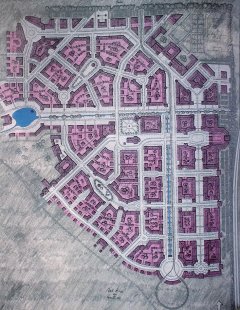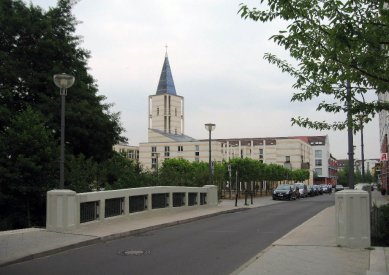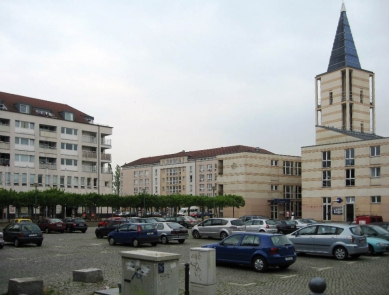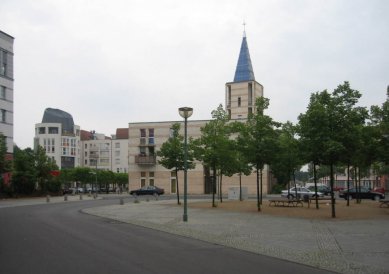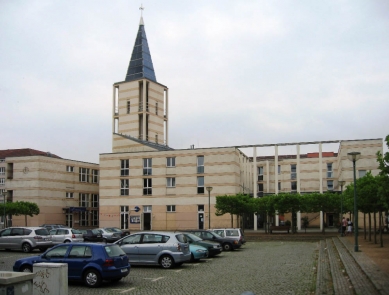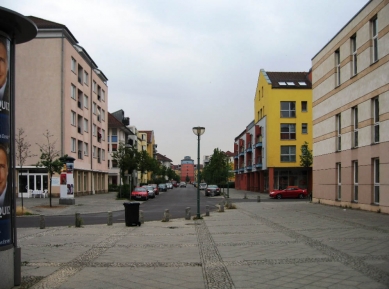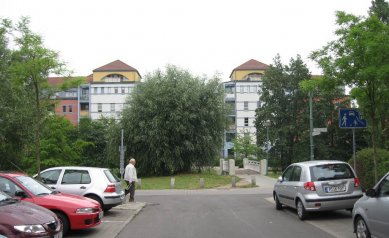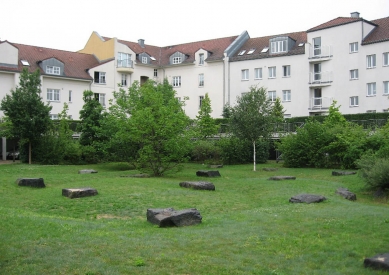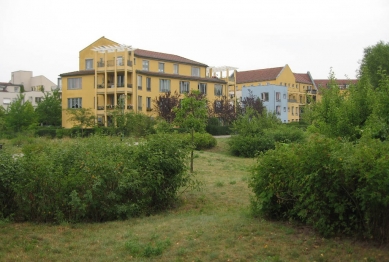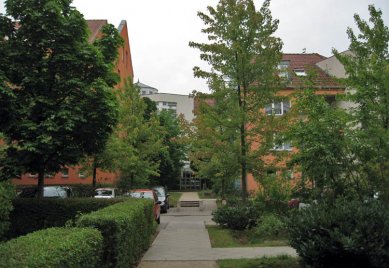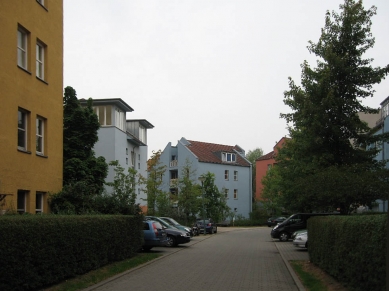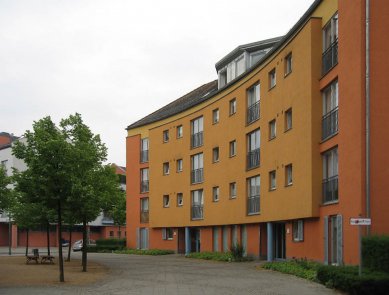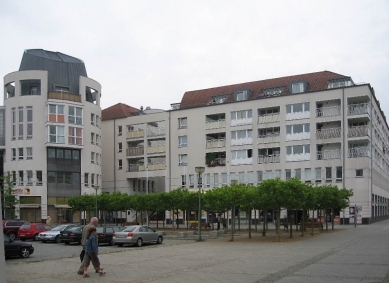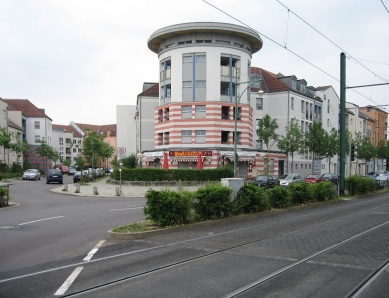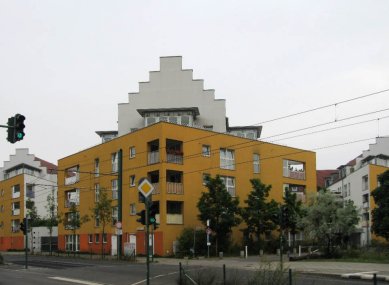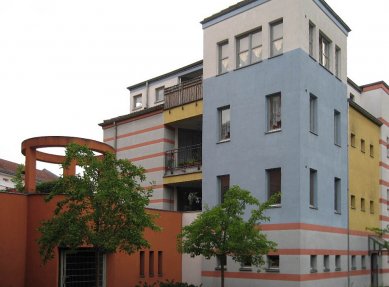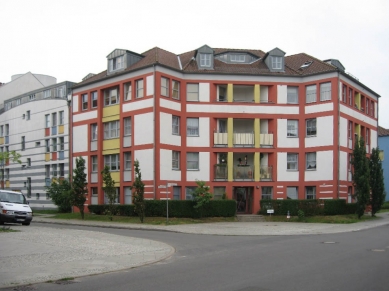
Quarter Kirchsteigfeld

Unlike most cities in the former GDR, Potsdam experienced an extraordinary increase in interest in housing during the first half of the nineties. It is no wonder. The pleasant size (approximately 140,000 inhabitants today), ample job opportunities in a city that has become the metropolis of the renewed federal state of Brandenburg, and of course in neighboring Berlin (a half-hour ride to the center), excellent recreational surroundings (lakes and arms of the Havel River, surrounding forests), cultural offerings, and first-class visual appeal are all enticing. With massive expenditures, the network of aristocratic residences, parks, and cultural landscapes is being restored, similar to what is happening in Berlin and Dresden, clearing away the worst modernist interventions into the historical fabric and reconstructing replicas of destroyed historic buildings (sometimes debatably schematized - the city castle as a future seat of the state parliament), and thanks to the organization of the Federal Garden Exhibition 2001, an extensive park with an ecological educational center was built on the site of the former military complex. Among the avant-garde new constructions, the Hans-Otto-Theater by Gottfried Böhm (2002-06) stands out, and an aquapark by Oscar Niemeyer is also planned.
Several new residential complexes have emerged, in simplified form connecting to traditional types of family or apartment villas or to the sober architecture of the interwar New Objectivity. Common features include a relatively small scale, an abundance of integrated greenery, and formal diversity without ostentatious stylistic excesses. The most extensive, distinct, and successful of these neighborhoods is Kirchsteigfeld on the southeastern edge of the city, built on previously agricultural land between the village of Drewitz and a panel housing estate. The developer, in collaboration with the town hall, entrusted the project to the Berlin duo Rob Krier – Christoph Kohl (Rob is the brother of Léon Krier, C. Kohl is Rob’s brother-in-law). They created the urban layout and binding regulations regarding scale, forms, and colors (masterplan), and subsequent architects then designed the individual buildings according to these guidelines.
Kirchsteigfeld develops around two perpendicular axes, a street, and a stream that has been bridged multiple times, featuring a lake, with a square located at their intersection marked by towering church and community center (A. Burelli) and a commercial and residential building (S.O.M.) that serve as dominant features. The adjacent streets with terraced houses or apartment villas utilize principles from Sitte's "building cities according to artistic principles," incorporating pedestrian zones, floor plan shifts, and tower or balcony accents within sight axes. Interior courtyards are partially passable, adorned with species-rich greenery and utilized for playgrounds or parks. The height of buildings is limited by the growth of trees, and residents’ cars do not mar the views as they park in courtyards beneath greened terraces, with rubbish bins cleverly hidden in refined yet easily accessible recesses. Among other "perks," noteworthy are the separate entrances to ground floor apartments with porches and front gardens, simulating the situation of a family house. The masterplan favored hipped roofs and traditional vertical divisions of facades with tall windows, allowing for a colorful but not arbitrary facade coloration. Thanks to the numerous architects involved, a diversity of building typologies was ensured and the desired impression of a naturally grown city was achieved. Some buildings feature plaques with the names of the designers. A tram connects Kirchsteigfeld to the center of Potsdam.
Kirchsteigfeld is regarded as one of the most consistent realizations of the so-called New Urbanism in Europe—a direction or movement that was established in 1993 in the USA and strongly advocates traditional urban forms against the so-called suburban sprawl, a loosely structured development that devastates the suburban landscape in relation to road arteries. While in America new traditionalist towns and neighborhoods arise quite frequently, such projects are less common in Europe, despite the fact that similar concepts have been present in theory since the 1960s, and as the Potsdam complex shows, users highly appreciate them. The main reason is likely the fact that the decline of urbanism and its negative social consequences in Europe have not yet reached the level seen in America, and thus the problem is not regarded as urgent—especially by local governments. However, modernist prejudices and clichés about "the style and needs of our time," "populism," etc., which surprisingly still persist among professionals in more civilized countries in western Europe, in contrast to the more pluralistic Anglo-American scene, also play a non-negligible role; for example, stalling the project to complete the Tacheles block in central Berlin according to designs by leading world traditionalists (masterplan Andrés Duany - Elizabeth Plater-Zyberk, with individual buildings designed in addition by Robert Stern, Calvin Tsao, Tom Beeby, Javier Cenicacelaya, Gabriele Tagliaventi, Piotr Choynowski, Demetri Porphyrios). Interestingly, the United States entrusted the prestigious execution of its Berlin embassy on Pariser Platz (completed in 2007) to the Moore Ruble Yudell studio, which also participated in the construction of Kirchsteigfeld and is designing a similar neighborhood, Karow Nord, for the same developer (Groth + Graalfs), blending "the traditions of garden cities with the German model of urban residential development." What is essential is what German advocates of New Urbanism say to critics of traditional forms: it is not primarily about these forms, but "above all about the restoration of the degraded sphere of public interest."
This contribution was created with the support of the Czech Science Foundation (postdoctoral grant 408/08/P167).
Several new residential complexes have emerged, in simplified form connecting to traditional types of family or apartment villas or to the sober architecture of the interwar New Objectivity. Common features include a relatively small scale, an abundance of integrated greenery, and formal diversity without ostentatious stylistic excesses. The most extensive, distinct, and successful of these neighborhoods is Kirchsteigfeld on the southeastern edge of the city, built on previously agricultural land between the village of Drewitz and a panel housing estate. The developer, in collaboration with the town hall, entrusted the project to the Berlin duo Rob Krier – Christoph Kohl (Rob is the brother of Léon Krier, C. Kohl is Rob’s brother-in-law). They created the urban layout and binding regulations regarding scale, forms, and colors (masterplan), and subsequent architects then designed the individual buildings according to these guidelines.
Kirchsteigfeld develops around two perpendicular axes, a street, and a stream that has been bridged multiple times, featuring a lake, with a square located at their intersection marked by towering church and community center (A. Burelli) and a commercial and residential building (S.O.M.) that serve as dominant features. The adjacent streets with terraced houses or apartment villas utilize principles from Sitte's "building cities according to artistic principles," incorporating pedestrian zones, floor plan shifts, and tower or balcony accents within sight axes. Interior courtyards are partially passable, adorned with species-rich greenery and utilized for playgrounds or parks. The height of buildings is limited by the growth of trees, and residents’ cars do not mar the views as they park in courtyards beneath greened terraces, with rubbish bins cleverly hidden in refined yet easily accessible recesses. Among other "perks," noteworthy are the separate entrances to ground floor apartments with porches and front gardens, simulating the situation of a family house. The masterplan favored hipped roofs and traditional vertical divisions of facades with tall windows, allowing for a colorful but not arbitrary facade coloration. Thanks to the numerous architects involved, a diversity of building typologies was ensured and the desired impression of a naturally grown city was achieved. Some buildings feature plaques with the names of the designers. A tram connects Kirchsteigfeld to the center of Potsdam.
Kirchsteigfeld is regarded as one of the most consistent realizations of the so-called New Urbanism in Europe—a direction or movement that was established in 1993 in the USA and strongly advocates traditional urban forms against the so-called suburban sprawl, a loosely structured development that devastates the suburban landscape in relation to road arteries. While in America new traditionalist towns and neighborhoods arise quite frequently, such projects are less common in Europe, despite the fact that similar concepts have been present in theory since the 1960s, and as the Potsdam complex shows, users highly appreciate them. The main reason is likely the fact that the decline of urbanism and its negative social consequences in Europe have not yet reached the level seen in America, and thus the problem is not regarded as urgent—especially by local governments. However, modernist prejudices and clichés about "the style and needs of our time," "populism," etc., which surprisingly still persist among professionals in more civilized countries in western Europe, in contrast to the more pluralistic Anglo-American scene, also play a non-negligible role; for example, stalling the project to complete the Tacheles block in central Berlin according to designs by leading world traditionalists (masterplan Andrés Duany - Elizabeth Plater-Zyberk, with individual buildings designed in addition by Robert Stern, Calvin Tsao, Tom Beeby, Javier Cenicacelaya, Gabriele Tagliaventi, Piotr Choynowski, Demetri Porphyrios). Interestingly, the United States entrusted the prestigious execution of its Berlin embassy on Pariser Platz (completed in 2007) to the Moore Ruble Yudell studio, which also participated in the construction of Kirchsteigfeld and is designing a similar neighborhood, Karow Nord, for the same developer (Groth + Graalfs), blending "the traditions of garden cities with the German model of urban residential development." What is essential is what German advocates of New Urbanism say to critics of traditional forms: it is not primarily about these forms, but "above all about the restoration of the degraded sphere of public interest."
Literature
Rob Krier - Christoph Kohl, The Making of a Town: Potsdam - Kirchsteigfeld, Bensheim: awf-verlag / London: Papadakis 1997.This contribution was created with the support of the Czech Science Foundation (postdoctoral grant 408/08/P167).
The English translation is powered by AI tool. Switch to Czech to view the original text source.
2 comments
add comment
Subject
Author
Date
wow
hetzer
12.08.08 04:42
cit pro město
Tomáš Lichtenberg
19.08.08 09:02
show all comments


